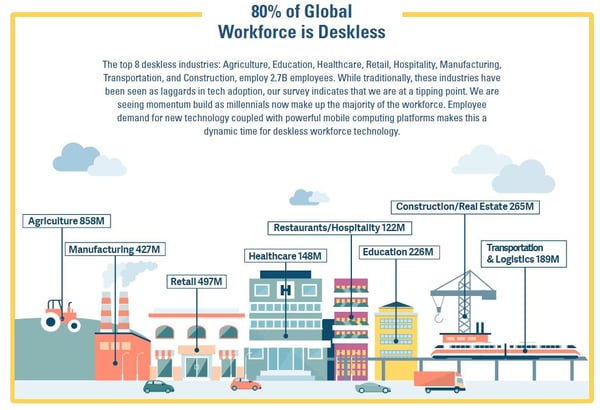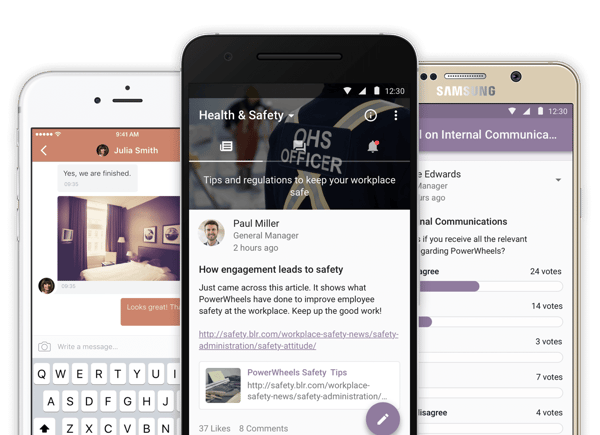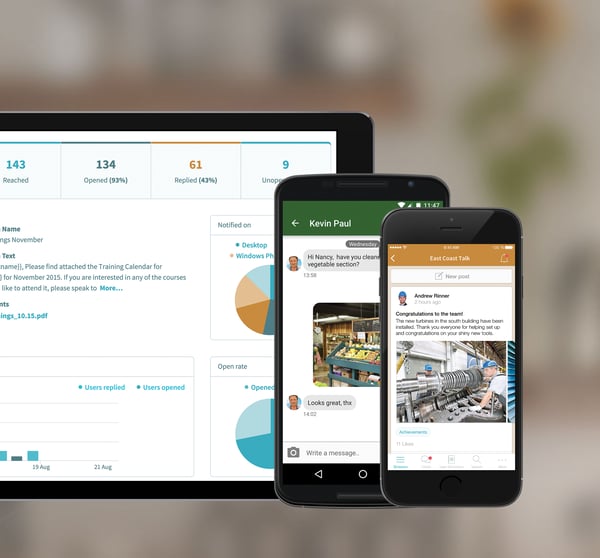
Companies are quite adept at managing how they communicate their messages outside the company and towards their target customers. They have entire departments and teams of experts that strategize an external communications strategy and implement this through a well-thought-out communications plan.
But what about internal communications? This is the act of conceptualizing and implementing a communications strategy targeted towards your own employees. This often does not receive the same attention and focus that external communications receives.
But why is this the case?
In any introductory marketing class, you will learn about the 4 Ps of marketing – Product, Place, Promotion and Price. You develop a Product to sell, you decide the distribution channels for the product (the Place), you develop the marketing/promotional strategy (the Promotion) and a Price that maximizes your profit for the product. The Promotion aspect is the external communications previously mentioned. While your employees will help deliver the 4 Ps, nothing is mentioned about how organizations will ensure that employees receive the needed information to do their jobs well.
This is why companies are beginning to recognize the importance of going to the next level in their approach to internal communications, especially with their difficult-to-reach mobile workers.
Here are 9 ways you can improve internal communications with your mobile workforce:
1. Communicate real-time with workers on the move
The number of mobile workers is increasing. In some industries, more than 80% of the workforce are non-desk bound workers whose day-to-day work requires them to be on the move. Industries like hospitality, logistics, retail and manufacturing are typical of this.

Many of these workers don’t even have a corporate email account and access to a company intranet. As a result, their access to important company information is sporadic at best. The good news is that there are options out there and no one needs to be left in the dark anymore.
Technology has become an enabler.. etc
2. Get updates on operational procedures and guidelines to employees quickly
In today’s dynamic work environment, expectations of front-line workers are high. Despite having to handle multiple tasks at the same time, they are also expected to deliver excellent customer service (and with a smile on their faces).
To make things even more complicated, companies update their operating procedures and guidelines a lot more regularly in order to continually improve their operations and keep up with competition and customer needs. This makes it imperative that these updates get out there promptly.

Let's look at the important aspect of Workplace Health and Safety. There is an integral relationship between operations efficiency and safety. Implementing real-time internal communications means you never have to choose between efficient operations and workforce safety with manifold benefits.
-
Immediate access to information - mobile-based communications allow employees to have immediate access to relevant information like safe work procedures and best practices. Instead of having to pull out a manual or make it back to a workstation, employees can use their mobile application to pull up exactly what they need when they need it. When an unfortunate workplace incident occurs, this immediate access has the potential to save lives.
-
Incident reporting - Unfortunately, near misses tend to go unreported when using traditional reporting methods. It can take too long to reach a workstation and the incident can be forgotten in the meantime. When employees can immediately report incidents, management gets a more accurate idea of the safety of work conditions. Offering employees the ability to report these issues right away also increases the employees’ faith in the company. Knowing that management cares and wants to be made aware of any issues can help employees stay engaged and motivated.
-
Safety feedback - A good mobile platform provides a safe and secure avenue for employees to provide this feedback while avoiding the pitfalls with typical reporting methods.
-
Instant notifications - There are a variety of reasons a company may need to contact all employees at once. Mobile communication can send alerts to all employees or specific groups, like those in the field, to update them to the proper procedures.
Building a culture of safety, where 'zero injuries' is the goal, is attainable with the right internal communications platform.
3. Communicate time-sensitive critical crises communications to your remote teams
Internal crises communication is the elephant in the room that is often not talked about. What happens when an unexpected event such as a fire or flooding strikes one of your locations?
While teams on the site of the event will be busy handling the situation and trying to get back to a normal situation, and the company’s external communications team is handling messages to the public, it’s important to also keep your internal teams abreast of the latest developments.
If organizations do not keep their internal teams informed about developments in a timely manner, they risk rumors and misinformation spreading across the organization thereby creating unnecessary stress and concern amongst employees.
A surprising number of companies still rely on crisis communication methods like phone trees, but those are an increasingly ineffective way to deploy workforce communications. Why? Studies have shown that 82% of employees would prefer to receive a text message instead of a voicemail — and a whopping 32% delete voicemails without ever listening to them!
Literally, everyone is holding a smartphone. It’s time to choose a new way. The App-based way.

4. Get regular feedback from your teams
It’s becoming more common practice in companies to do employee surveys to gauge the pulse of the organization. This is a good thing of course. The problem arises when these employee surveys are done only once or twice a year.
According to Mercer's Global Talent Trends 2019 more companies are listening to employees more frequently to improve business outcomes.
 Source: Mercer's Global Talent Trends 2019
Source: Mercer's Global Talent Trends 2019
With the technology that is available today, it is quite possible to do frequent surveys, even weekly or monthly, to have a quick check of how employees are feeling about particular issues. Surveys can be focused and short (even with 5 short questions) and targeted towards getting feedback on very specific issues.
Doing so allows you to get the real-time employee feedback and data you need to make any suggested or necessary changes to improve the effectiveness of your internal communications program. At this stage, it's imperative to be sure you actually act on the employee feedback survey results. An HBR.com study showed that 52% of upper management reviewed surveys but took no action. Automating the feedback process doesn’t do any good if the results aren’t put to good use.
5. Communicate success stories and best practices to create a positive work vibe
In days gone by, employees had to wait every quarter to get information and stories about people and events in a company. This was done through the quarterly employee newsletter that would be distributed in electronic form via email or through hard copies.
With the pace of business today, this seems a bit outdated. Why not leverage technology to get short success stories out to all employees on a regular, even daily basis so that the stories are current? By doing this, organizations will start mirroring how employees are now used to getting bite-sized information through various digital social media channels.
While the social aspects of any workplace are important, employees are looking for meaningful engagement around their work that helps to inform, motivate, and inspire their day-to-day contributions and connection to the organization’s bigger mission and goals.
For example, featuring employees in short blog posts how they have been living your "corporate values in action" recognizes them and shows the rest of the geographically disbursed team behaviors that exemplify the company's core values.
Recognition programs tied to values are more than two times as likely to be focused on reinforcing and driving business goals and 29 percent more likely to be focused on creating a positive employer brand. And let's not forget a company's values and brand is all about the people representing it in front of customers, vendors, and all other stakeholders.

6. Use data analytics to understand communication patterns better
With the current internal communications technology available out there, there is a possibility to leverage smartphones (which most employees already have in their hands) and get information out to non-desk employees who are often kept in the dark.
Some companies revert to what seems to be the easiest option available and use readily available social messaging apps to communicate with their mobile workers. Unfortunately, these social/consumer tools have limitations and are a far cry away from more sophisticated corporate internal communications platforms. Companies will be striving towards managing their messages to employees a lot better. For that a real-time feedback loop on how communications are being received, perceived, and engaged with is essential. Gathering people data in real-time for better management decisions is a trend Deloitte has identified back in 2016 already (pages 87 ff).

For example, analytics can help to identify the "informal opinion leaders" more easily. Once the internal communications leadership knows who those “cheerleaders” are, it can involve them to help communicate change within the organization. Every company has the twenty percent that are totally committed and the twenty percent that will never be committed. Engagement is meant to inspire the sixty percent that can become strong contributors. Having those “cheerleaders” at various levels lead lateral communication on your platform introduces new and current employees to the objectives of a change project. A strong way to maintain engagement during transformation.
7. Automate routine information dissemination
Automating many of the most common digital workplace operations, such as re-occurring on-boarding (SOPs, guidelines, and policies) or shift notifications, is another method of incorporating internal communications trends. When you set up templates and mailing lists one time and delegate the distribution to an event-triggered process productivity is vastly enhanced.
The employee experience could seamlessly continue after the new addition to the team has signed the employment contract. With a Mobile App and a semi-automated onboarding experience, you can start building rapport before the employee enters your office. With bite-sized information to their mobile phone, you drip feed multi-media content that is in sync with how we operate as humans; we can't possibly retain all the information that's parcelled up for us on day one.

8. Social recognition of frontline employees and remote workers
Social recognition technology is a platform that enables companies to recognize and validate behaviors and empower employees to share their work. It provides unlimited access to non-monetary recognition. Social recognition on a smartphone App digitalizes the way employees are recognized, encourages peer-to-peer recognition, celebrates sales incentives, or years of service.
An App makes the recognition highly visible within the organization to strengthen the company culture and celebrate shared victories. Relying solely on supervisors to offer recognition to subordinates is outdated. In today’s increasingly global business environments, there is a growing need to enable and encourage location-independent peer-to-peer recognition tools.
This decentralizes recognition and empowers all employees to recognize great work and effort as and when it happens allowing employees to get to know the company and each other. The resulting camaraderie plays the true motivating role in encouraging employees to outperform expectations.
For example, when JetBlue implemented a peer-to-peer recognition system that was built on company values, its employee satisfaction surged by 88 percent.
9. Bridge communication gaps caused by language barriers
Miscommunication is expensive. Due to high levels of linguistic and cultural diversity within the non-desk workforce, it is beneficial to adopt a digital communication platform that provides instant inline translation. The benefits of instant inline translation are relatively self-evident. When your entire workforce is given the opportunity to read and understand the information in their native language, you are inherently setting your organization up for increased safety, stronger peer-to-peer trust, and a lessened learning curve for team members in the onboarding process.
Digitally enabled culturally inclusive communication poises your business for unprecedented global expansion.
In summary, digital workplace trends indicate that incorporating more automation simplifies internal communications. Using internal communications tools, like digital workplace technology, can go a long way in improving communications and productivity for your workforce. In fact, using enterprise social media to improve workforce communications could increase productivity by up to 25%.
Don’t be shy and leverage the power of readily available and proven technology to get stuff done.



